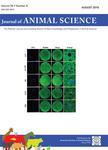版权所有:内蒙古大学图书馆 技术提供:维普资讯• 智图
内蒙古自治区呼和浩特市赛罕区大学西街235号 邮编: 010021

作者机构:Nat Resources Inst Finland Luke Econ & Soc FI-60320 Seinajoki Finland Nat Resources Inst Finland Luke Green Technol FI-31600 Jokioinen Finland MTT Agrifood Res Finland Econ Res FI-00790 Helsinki Finland MTT Agrifood Res Finland Anim Prod Res FI-31600 Jokioinen Finland
出 版 物:《JOURNAL OF ANIMAL SCIENCE》 (畜牧学杂志)
年 卷 期:2015年第93卷第8期
页 面:4161-4171页
核心收录:
基 金:Ministry of Agriculture and Forestry in Finland Finnish Cultural Foundation Faba Breeding Central Union of Agricultural Producers and Forest Owners (MTK)
主 题:Gompertz growth model nitrogen excretion pig breeding stochastic dynamic programming
摘 要:The selection of animals for improved performance affects the profitability of pig fattening and has environmental consequences. The goal of this paper was to examine how changes in genetic and market parameters impact the biophysical (feeding patterns, timing of slaughter, nitrogen excretion) and economic (return per pig space unit) results describing pig fattening in a Finnish farm. The analysis can be viewed as focusing on terminal line breeding goals. An integrated model using recursive stochastic dynamic programming and a biological pig growth model was used to estimate biophysical results and economic values. Combining these models allowed us to provide more accurate estimates for the value of genetic improvement and, thus, provide better feedback to animal breeding programs than the traditional approach, which is based on fixed management patterns. Besides the benchmark scenario, the results were simulated for 5 other scenarios. In each scenario, genotype was improved regarding daily growth potential, carcass lean meat content, or the parameters of the Gompertz growth curve (maturing rate [phi(i)], adult weight of protein [alpha(p)], and adult weight of lipid mass [alpha(L)]). The change in each parameter was equal to approximately 1 SD genetic improvement (ceteris paribus). Increasing phi(i), alpha(p), daily growth potential, or carcass lean meat content increased the return on pig space unit by (sic)12.60, (sic)7.60, (sic)4.10, or (sic)2.90 per year, respectively, whereas an increase in aL decreased the return by (sic)3.10. The genetic improvement in aL and fi resulted in the highest decrease in nitrogen excretion calculated in total or per kilogram of carcass gain but only under the optimal feeding pattern. Simulated changes in the Gompertz growth function parameters imply greater changes in ADG and lean meat content than changes in scenarios focusing on improving ADG and lean meat content directly. The economic value of genetic improvements as well as the